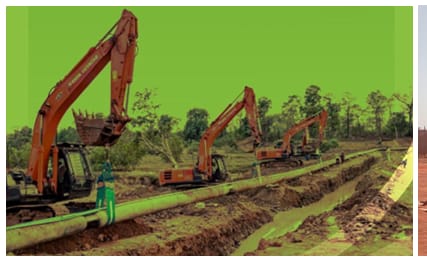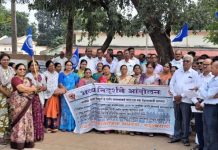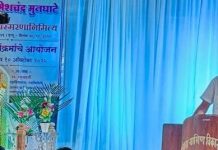
Gadchiroli June 5 (District Correspondent) After decarbonizing the mining operations, Lloyds Metals and Energy Ltd (LMEL) is focusing on green logistics too in Gadchiroli district, which is an emerging steel manufacturing hub. It has reduced carbon footprint in iron ore transportation by introducing a 87 KM long slurry pipeline from the grinding plant at Hedri to the pellet plant at Konsari.
The laying of the said slurry pipeline from the grinding plant at Surjagarh Iron Ore Mines to Konsari has been completed. The testing of the pipeline also has been completed successfully. The slurry pipeline represents Green Logistics that LMEL has adopted out of the commitment to environment, sustainability, and responsible industrial operations. Mr. B. Prabhakaran, Managing Director, LMEL, highlighted the significance of this achievement, stating, “The commissioning of this slurry pipeline is a momentous occasion, marking the first such project in India after a gap of 11 years. Importantly, this will be the fourth operational iron ore slurry pipeline in the entire nation and a pioneering one for the state of Maharashtra. This achievement firmly positions Lloyds Metals and Energy Ltd as a true pioneer in the region.”
The pipeline is estimated to reduce the freight cost by Rs 500-600 per tonne. The slurry pipeline has a dual advantage — lower freight cost and reduced carbon footprint — reflecting LMEL’s environmental responsibility.
There are two scenarios involved in transportation of iron ore – one in which coal-based power is used, and the other in which renewable energy is used. Considering the use of coal-based power scenario, carbon emission is around 11 kg/ton if the material (iron ore) is transported by road. This equates to 1.1 lakh tons of carbon emission on a yearly basis. But, with transportation through the slurry pipeline, as much as 61,000 tons (55%) of carbon emission on a yearly basis can be reduced. In effect, the carbon emission reduction is 184 tons/day, 5,000 tons/month, and 61,000 tons/year. If renewable energy is used, carbon emission can be reduced to 100%, that is, the entire 1.1 lakh tons of carbon emission on a yearly basis can be reduced. LMEL’s endeavour is to achieve this goal in the near future. In this particular scenario, the carbon emission reduction will be 333 tons/day, that is, around 9,200 tons/month.
3 LAKH SAPLINGS PLANTED
Minimizing waste, focusing on using green energy, reducing carbon footprint are only some components of the environmental commitment of Lloyds Metals and Energy Ltd (LMEL). Under LMEL’s ‘Mission Green’ initiative, inspired by the vision of producing India’s ‘green steel’, over 3 lakh trees have been planted at various locations, and thousands of saplings have been distributed to people, who are important stakeholders in securing a green future for all.
In line with forest clearance conditions, LMEL allocated 377.58 hectares of private land in Arvi and Karanja talukas of Wardha district for compensatory afforestation, in lieu of 374.90 hectares diverted for Surjagarh Iron Ore Mine. LMEL deposited Rs 2.49 crore with the Compensatory Afforestation Fund Management and Planning Authority (CAMPA). Within the compensatory afforestation area, 2,56,388 native saplings, planted by the State Forest Department in Arvi taluka, have taken root, and this land was declared a reserved forest on June 16, 2023. This speaks volumes about the success of the initiative.
At the Surjagarh mines, LMEL has planted 5,285 native saplings within the safety zone area and an additional around 14,000 saplings along the roads from Etapali to Hedri. To engage the local community, fruit gardens have been established by planting 1,800 saplings and distributing over 9,500 fruit-bearing saplings to residents.
At the DRI plant (Unit-2) in Konsari, LMEL has planted approximately 50,000 saplings in 17 hectares within the premises, selecting native species in coordination with the local Forest Department.
Further, the green-belt development includes diverse native species. To further environmental awareness, LMEL has also distributed and planted around 19,000 fruit-bearing plants to villagers, encouraging development of fruit gardens.






